Surface availability of beta-glucans is critical determinant of host immune response to Cladosporium cladosporioides
- PMID: 23403046
- PMCID: PMC6145803
- DOI: 10.1016/j.jaci.2013.01.003
Surface availability of beta-glucans is critical determinant of host immune response to Cladosporium cladosporioides
Abstract
Background: It is well accepted that mold exposure is a major contributor to the development of asthma, and beta-glucans are often used as a surrogate for mold exposure in the environment. Beta-glucans are an important component of mold spores and are recognized by the immune system by their receptor, Dectin-1. Cladosporium cladosporioides spores have a high beta-glucan content, but the beta-glucans are not available on the surface of live spores.
Objective: We sought to determine whether altering the exposure of beta-glucans in C cladosporioides through heat killing could alter the immune response through binding to Dectin-1.
Methods: In a murine model of mold-induced asthma, mice were repeatedly exposed to either live or heat-killed C cladosporioides and the phenotype was determined by the measurement of airway hyperresponsiveness, airway inflammation, and cytokine production. Pro-inflammatory cytokines from dendritic cells were measured by using quantitative PCR and ELISA.
Results: Live C cladosporioides induced robust airway hyperresponsiveness, eosinophilia, and a predominately TH2 response, while heat-killed C cladosporioides induced a strong TH17 response and neutrophilic inflammation, but very mild airway hyperresponsiveness. Heat killing of C cladosporioides spores effectively exposed beta-glucans on the surface of the spores and increased binding to Dectin-1. In the absence of Dectin-1, heat-killed spores induced a predominantly TH2 response analogous to live spores. Furthermore, the production of TH17-skewing IL-6, IL-23, and TNF-α by dendritic cells in response to heat-killed C cladosporioides was dependent on Dectin-1.
Conclusions: The host immune response to C cladosporioides is dependent on the surface availability of beta-glucans rather than the total beta-glucan content.
Copyright © 2013 American Academy of Allergy, Asthma & Immunology. Published by Mosby, Inc. All rights reserved.
Conflict of interest statement
Disclosure of potential conflict of interest: R. A. Mintz-Cole has been supported by a Ruth L. Kirschstein NRSA Individual Fellowship. T. Reponen has received one or more grants from or has one or more grants pending with the US HUD (contract from the Centers for Disease Control and Prevention). G. K. Khurana Hershey has received one or more grants from or has one or more grants pending with the National Institutes of Health. The rest of the authors declare that they have no relevant conflicts of interest.
Figures


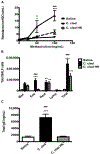
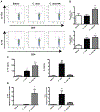
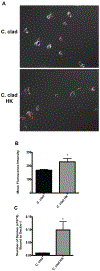
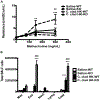
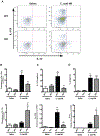

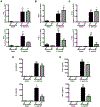
Similar articles
-
Assessment of the pulmonary adaptive immune response to Cladosporium cladosporioides infection using an experimental mouse model.Sci Rep. 2021 Jan 13;11(1):909. doi: 10.1038/s41598-020-79642-y. Sci Rep. 2021. PMID: 33441700 Free PMC article.
-
Dectin-1 and IL-17A suppress murine asthma induced by Aspergillus versicolor but not Cladosporium cladosporioides due to differences in β-glucan surface exposure.J Immunol. 2012 Oct 1;189(7):3609-17. doi: 10.4049/jimmunol.1200589. Epub 2012 Sep 7. J Immunol. 2012. PMID: 22962686 Free PMC article.
-
Aspergillus fumigatus triggers inflammatory responses by stage-specific beta-glucan display.PLoS Pathog. 2005 Nov;1(3):e30. doi: 10.1371/journal.ppat.0010030. Epub 2005 Nov 18. PLoS Pathog. 2005. PMID: 16304610 Free PMC article.
-
Contribution of dectin-1 and granulocyte macrophage-colony stimulating factor (GM-CSF) to immunomodulating actions of beta-glucan.Int Immunopharmacol. 2008 Apr;8(4):556-66. doi: 10.1016/j.intimp.2007.12.011. Epub 2008 Jan 16. Int Immunopharmacol. 2008. PMID: 18328447 Review.
-
Innate immunity induced by fungal β-glucans via dectin-1 signaling pathway.Int J Med Mushrooms. 2014;16(1):1-16. doi: 10.1615/intjmedmushr.v16.i1.10. Int J Med Mushrooms. 2014. PMID: 24940900 Review.
Cited by
-
Modulation of Human Immune Response by Fungal Biocontrol Agents.Front Microbiol. 2017 Feb 3;8:39. doi: 10.3389/fmicb.2017.00039. eCollection 2017. Front Microbiol. 2017. PMID: 28217107 Free PMC article. Review.
-
β-Glucan exacerbates allergic asthma independent of fungal sensitization and promotes steroid-resistant TH2/TH17 responses.J Allergy Clin Immunol. 2017 Jan;139(1):54-65.e8. doi: 10.1016/j.jaci.2016.02.031. Epub 2016 Apr 20. J Allergy Clin Immunol. 2017. PMID: 27221135 Free PMC article.
-
The Interaction of Human Pathogenic Fungi With C-Type Lectin Receptors.Front Immunol. 2018 Jun 4;9:1261. doi: 10.3389/fimmu.2018.01261. eCollection 2018. Front Immunol. 2018. PMID: 29915598 Free PMC article. Review.
-
Assessment of the pulmonary adaptive immune response to Cladosporium cladosporioides infection using an experimental mouse model.Sci Rep. 2021 Jan 13;11(1):909. doi: 10.1038/s41598-020-79642-y. Sci Rep. 2021. PMID: 33441700 Free PMC article.
-
Environmental exposures and mechanisms in allergy and asthma development.J Clin Invest. 2019 Apr 1;129(4):1504-1515. doi: 10.1172/JCI124612. Epub 2019 Feb 11. J Clin Invest. 2019. PMID: 30741719 Free PMC article. Review.
References
-
- Eduard W Fungal spores: a critical review of the toxicological and epidemiological evidence as a basis for occupational exposure limit setting. Crit Rev Toxicol 2009;39:799–864. - PubMed
-
- Belanger K, Beckett W, Triche E, Bracken MB, Holford T, Ren P, et al. Symptoms of wheeze and persistent cough in the first year of life: associations with indoor allergens, air contaminants, and maternal history of asthma. Am J Epidemiol 2003;158:195–202. - PubMed
-
- Halonen M, Stern DA, Wright AL, Taussig LM, Martinez FD. Alternaria as a major allergen for asthma in children raised in a desert environment. Am J Respir Crit Care Med 1997;155:1356–61. - PubMed
-
- Black PN, Udy AA, Brodie SM. Sensitivity to fungal allergens is a risk factor for life-threatening asthma. Allergy 2000;55:501–4. - PubMed
Publication types
MeSH terms
Substances
Grants and funding
LinkOut - more resources
Full Text Sources
Other Literature Sources

